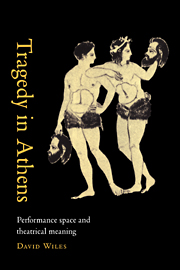Book contents
- Frontmatter
- Contents
- List of illustrations
- Acknowledgements
- List of abbreviations
- 1 The problem of space
- 2 The Theatre of Dionysus
- 3 Focus on the centre point
- 4 The mimetic action of the chorus
- 5 The chorus: its transformation of space
- 6 Left and right, east and west
- 7 Inside/outside
- 8 The vertical axis
- 9 The iconography of sacred space
- 10 Orchêstra and theatron
- Select bibliography
- Index
4 - The mimetic action of the chorus
Published online by Cambridge University Press: 06 January 2010
- Frontmatter
- Contents
- List of illustrations
- Acknowledgements
- List of abbreviations
- 1 The problem of space
- 2 The Theatre of Dionysus
- 3 Focus on the centre point
- 4 The mimetic action of the chorus
- 5 The chorus: its transformation of space
- 6 Left and right, east and west
- 7 Inside/outside
- 8 The vertical axis
- 9 The iconography of sacred space
- 10 Orchêstra and theatron
- Select bibliography
- Index
Summary
Within the architectural space of the Theatre of Dionysus, the most important spatial relationship is that of actor and chorus. Both shared the same acting space, and there was no ‘low stage’ removing the chorus from the audience's field of vision at times when it took no part in the dialogue. The reader of a Greek tragedy can all too easily forget that the chorus is present. The reader of a tragedy in translation is in a particularly parlous position because the choral odes with their dense metaphors and mythic allusions often appear impenetrable by comparison with the dialogue, and it is easy to slide across the words. The fifth-century spectator was never able to forget the presence of twelve or at some points fifteen bodies placed in some kind of space relationship to the actors.
The terms in which Plato satirizes tragic performance are revealing:
In our part of the world [i.e. Athens] what happens is pretty much the same as in every polis. After the government has made a public sacrifice, there comes a chorus, not one group but a host of choruses. These place themselves not far from the altars, often right next to them, where over the offerings they emit complete blasphemies: speeches, rhythms and tunes in the form of lamentation. Whichever has instant success in drawing tears from the polis that is making sacrifice wins the prize.
Although competition and choral dancing were features of many other festivals, Plato alludes to tragedy here because of the emotions that the chorus generates, and an apparent disrespect for the gods.
- Type
- Chapter
- Information
- Tragedy in AthensPerformance Space and Theatrical Meaning, pp. 87 - 113Publisher: Cambridge University PressPrint publication year: 1997



